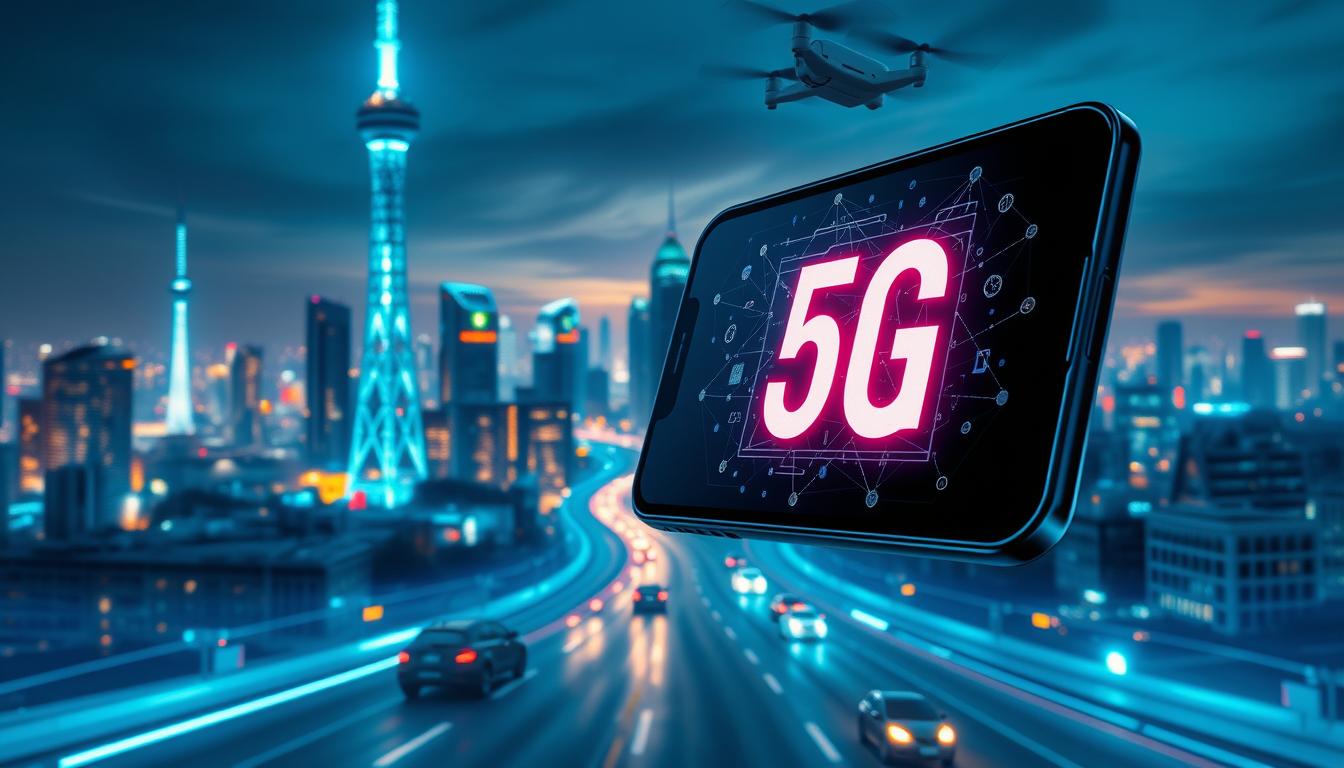5G is more than just faster internet. This fifth generation technology is a leap forward in connectivity, promising speeds up to 100 times faster than 4G. It’s not just about downloading movies in seconds—it’s about reshaping how we live, work, and connect globally.
From smart homes to remote surgeries, 5G’s low latency and massive device capacity are driving innovations. This shift impacts everything from daily routines to global industries, making seamless connectivity a cornerstone of modern life.
Key Takeaways
- 5G delivers ultra-fast speeds and near-instant data transmission.
- Fifth generation technology connects billions of devices, powering the Internet of Things (IoT).
- Businesses and households will see smarter automation and real-time data access.
- 5G is essential for emerging tech like self-driving cars and virtual reality.
- Its rollout is a global race led by companies like Verizon and AT&T.
Understanding 5G Technology and Its Benefits
5G technology isn’t just a speed upgrade—it’s a leap forward in how we connect. Let’s explore what makes it different and why it matters.
What is 5G?
5G uses new radio frequencies to deliver faster data transfer. Unlike 4G, it reduces delays and supports more devices simultaneously. This 5g technology forms the backbone of modern digital systems, enabling everything from smart home devices to self-driving cars.
Key Advantages of 5G
- Speed: Download full-length movies in seconds, not minutes.
- Low Latency: Near-instant response times for gaming and remote surgery.
- Capacity: Handle thousands of devices in one area without slowdowns.
| Aspect | 4G | 5G |
|---|---|---|
| Speed | Up to 100 Mbps | Up to 20 Gbps |
| Latency | 50-100 ms | 1 ms or less |
| Devices Supported | Millions | Billions |
The Role of 5G in Connectivity
The 5g network isn’t limited to phones. It connects smart devices, traffic lights, and even farm sensors. Cities use it to manage energy grids, while hospitals use it for real-time patient monitoring. These 5g benefits make everyday life smoother and more efficient.
The Evolution of Wireless Technology
Wireless communication has come a long way since the first cellphones. Each generation of technology has expanded what’s possible, with 5G now setting new standards. Let’s look back to see how we got here.
From 1G to 5G: A Brief History
The journey began in the 1980s with 1G—basic voice calls using analog signals. By the 1990s, 2G brought digital calls and text messaging. The 2000s saw 3G enable mobile internet, while 4G in the 2010s delivered streaming and instant access. Now, fifth generation technology takes speed and connectivity to unprecedented levels.
Major Milestones in Wireless Development
Key moments reshaped how we use wireless tech:
- 1983: Motorola’s first 1G phone, the DynaTAC 8000X
- 1991: Finland launched the first 2G network, enabling SMS
- 2001: 3G arrived, making web browsing on phones possible
- 2009: 4G standards set the stage for video calls and cloud services
- 2020: 5G networks began global rollout, promising gigabit speeds
These steps show a pattern of exponential growth. Each leap prepared the ground for the next, with 5G now unlocking possibilities like real-time IoT and smart cities. This progression isn’t just faster—it’s smarter, connecting everything from cars to healthcare devices.
Impact of 5G on Daily Life
5G applications are already starting to redefine everyday activities, blending speed and connectivity into routines. This technology isn’t just for tech enthusiasts—it’s about making life simpler, faster, and safer.
Enhanced Mobile Experiences
5G speed turns phones into powerful tools. Imagine:
- Watching 4K movies without buffering
- Playing online games with zero lag
- Using AR apps to explore 3D maps or translate menus instantly
These experiences rely on 5G’s ultra-fast speeds and low latency.
Revolutionizing Smart Homes
Smart homes powered by 5G applications become truly “smart.” Devices like security cameras, thermostats, and doorbells sync seamlessly. Examples include:
- Real-time security alerts sent directly to your phone
- Energy-efficient systems that adjust based on your location
- Automated lighting and temperature control
5G’s reliability ensures no dropped connections, even with dozens of devices.
Improved Health Care Technology
Health care becomes more accessible. Doctors can monitor patients remotely using 5G-enabled wearables. Telemedicine visits offer HD video quality, while hospitals use 5G speed for:
- Instantly sharing medical scans
- Guided robotic surgeries by specialists miles away
- Emergency teams sharing patient data en route to hospitals
Everyday tasks—from gaming to home security to doctor visits—get faster and smarter with 5G. This is the future of convenience, one connection at a time.
5G and the Internet of Things (IoT)
Imagine a world where everyday objects like streetlights and farming tools communicate seamlessly. The 5G network is making this vision a reality by fueling the IoT revolution.

What is IoT?
IoT refers to devices like smart thermostats or fitness trackers that connect to the internet. These gadgets collect data to automate tasks, from adjusting home temperatures to monitoring crop health. Think of it as a digital nervous system linking physical devices.
5G’s Role in IoT Devices
The 5g network unlocks IoT’s potential through three key traits:
- Speed: Processes data instantly for real-time responses
- Capacity: Connects millions of devices without slowing down
- Energy Efficiency: Extends battery life for sensors in remote areas
Real-World IoT Examples Powered by 5G
| Application | 5G Feature Used | Impact |
|---|---|---|
| Smart Traffic Management | Ultra-low latency | Adjusts traffic lights in real time to reduce congestion |
| Factory Automation | Massive device connectivity | Enables synchronized machinery for safer, faster production |
| Precision Agriculture | Extended coverage | Monitors soil moisture across vast farmlands to save water |
5G in Industries: Transforming Business Operations
5G applications are reshaping how industries operate, offering unprecedented speed and reliability. From assembly lines to logistics networks, businesses leverage 5G to streamline operations and unlock new opportunities. Improved 5g coverage ensures seamless connectivity even in remote or complex environments.
Manufacturing and Automation
Smart factories use 5G to automate assembly lines and monitor equipment in real time. Predictive maintenance tools reduce downtime by 40%, as seen in automotive plants adopting IoT sensors. Flexible manufacturing setups allow on-demand production shifts, cutting costs.
- Real-time quality control via high-speed data
- Robotics coordination with minimal latency
Telecommunications
Telecom providers like Verizon and AT&T deploy 5G networks to offer tailored services. Network slicing allows businesses to create dedicated virtual networks for specific needs, such as healthcare or retail. Improved 5g coverage in rural areas expands service reach, boosting enterprise partnerships.
“5G isn’t just faster—it’s a platform for reimagining business models.” — Verizon 2023 Innovation Report
Transportation and Logistics
5G enables real-time tracking of shipments and autonomous vehicle testing. Companies like UPS use 5G sensors to monitor cargo conditions, reducing delays. Enhanced 5g coverage supports connected fleets, slashing delivery times by 25% in pilot programs.
| Industry | 5G Applications | Outcomes |
|---|---|---|
| Manufacturing | Predictive maintenance, robotics | 40% downtime reduction |
| Telecom | Network slicing, IoT integration | New revenue streams |
| Transportation | Fleet tracking, autonomous tech | 25% faster deliveries |
The Challenges of 5G Implementation
Rolling out a 5G network faces real-world obstacles. From technical demands to policy debates, these hurdles shape how quickly 5G becomes universal.

Infrastructure Requirements
Building a robust 5g coverage system demands massive upgrades. Key issues include:
- Small cell networks: Thousands of compact towers need placement in urban and rural areas.
- Fiber backhaul: Existing cables often can’t handle 5G’s high-speed demands.
- Spectrum costs: Auctioning frequencies strains budgets for carriers and governments.
Security Concerns
“Every new connection point is a potential vulnerability,” warn telecom analysts.
5G’s distributed architecture creates risks like:
- Increased attack surfaces for hackers.
- Data privacy threats from interconnected IoT devices.
- Weaknesses in open radio access networks (O-RAN).
Regulatory Hurdles
| Challenge | Description |
|---|---|
| Local permitting delays | City approvals for cell sites often take years. |
| Global standards | Disputes over 5G protocols slow cross-border tech sharing. |
| Supply chain issues | Geopolitical tensions limit hardware sourcing options. |
Addressing these hurdles requires collaboration between governments, carriers, and tech firms. Balancing innovation with practicality ensures 5G’s promise isn’t overshadowed by its complexities.
Future Innovations Driven by 5G
5G’s potential extends far beyond faster downloads. This transformative technology is the backbone for innovations that will reshape industries and daily routines. From virtual tools to life-saving systems, here’s how 5G’s 5g applications are paving the way for tomorrow’s world.
Advancements in Augmented Reality (AR)
AR is evolving from gimmicks to essential tools. With 5G’s 5g speed, real-time overlays can guide technicians repairing complex machinery or let shoppers see furniture in their homes before buying. Imagine medical students practicing surgeries via AR simulations with no lag. These use cases rely on 5G’s ultra-low latency to deliver immersive, actionable experiences.
- Industrial training for hazardous job simulations
- AR shopping apps with instant 3D product previews
- Remote AR assistance for on-site repairs
New Possibilities in Telemedicine
Telemedicine is leaping forward. 5G’s reliability enables live high-definition video feeds for remote specialists to guide local doctors during critical procedures. Wearables using 5g applications will monitor patients continuously, sending alerts to hospitals if heart rates spike. These tools could cut emergency response times in rural areas by connecting patients to specialists thousands of miles away.
Evolution of Autonomous Vehicles
Self-driving cars need instant communication to avoid accidents. 5G’s 5g speed ensures vehicles exchange data with traffic lights and other cars in milliseconds. Cities like Las Vegas and Barcelona are already testing 5G-powered traffic systems. Soon, fleets of autonomous delivery trucks could navigate highways safely, relying on 5G’s real-time data streams to react to road changes instantly.
The Global Race for 5G Deployment
As 5G reshapes global tech landscapes, nations compete to lead in 5G network adoption. Countries like South Korea and China have rolled out widespread 5G coverage, while the U.S. and European nations accelerate infrastructure investments. This race isn’t just about speed—it’s a strategic move to secure economic and technological dominance.
Countries Strategies in the 5G Sprint
- South Korea: First to launch 5G commercially, focusing on urban 5g coverage and partnerships with Samsung.
- China: Prioritizes state-backed 5G infrastructure, aiming for 600 million users by 2025.
- U.S.: Balances private investment with federal spectrum auctions, targeting rural 5g network expansion.
Telecom Giants Shaping the 5G Landscape
Verizon and AT&T are U.S. pioneers, investing billions in 5G towers and millimeter wave technology. Verizon’s “5G Ultra Wideband” emphasizes city coverage, while AT&T focuses on expanding rural 5g coverage through low-band spectrum.
Global Partnerships and Agreements
“5G standards require collaboration, not competition,” says a 3GPP official. This alliance unites 80+ companies to standardize 5G tech.
International deals, like EU-U.S. spectrum agreements, aim to avoid fragmentation. Yet tensions over supply chains persist, with debates around Huawei’s role in global 5g network rollout.
How to Prepare for a 5G Future
Making the most of 5G starts with smart choices today. Whether upgrading devices, choosing plans, or setting up home networks, small steps now can unlock 5G benefits long-term.
Check Device Compatibility First
Look for phones or hotspots from brands like Samsung, Apple, or Motorola that support all three 5G bands. Mid-band devices offer a balance of coverage and 5G speed, while millimeter wave models excel in urban areas. Check carrier lists to avoid buying gear that only works in limited zones.
Compare Carrier Plans Wisely
Verizon, AT&T, and T-Mobile all offer 5G plans, but speeds vary. Compare data limits, early termination fees, and value-added perks like free streaming. Mid-tier plans often provide enough 5G speed for most users without overpaying for unused bandwidth.
Upgrade Home Networks Thoughtfully
For home setups, consider 5G routers from Netgear or ASUS. These devices turn cellular signals into Wi-Fi, ideal for rural areas lacking broadband. Place antennas near windows for best reception and pair them with mesh networks to spread coverage evenly.
Take time to research instead of rushing. Test 5G hotspots before committing to new contracts. Waiting a few months can mean better 5G benefits at lower costs as networks expand. Letting technology mature ensures smarter investments without overpaying for early-stage tech.

Leave a Reply